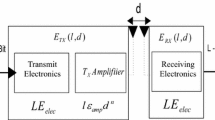Abstract
The lower layer of ubiquitous and pervasive systems consists of wireless ad hoc and sensor networks. In wireless sensor networks (WSNs), sensors consume most of their energy in data transmission and idle listening. Hence, efficient usage of energy can be ensured by improved protocols for topology control (i.e., coverage and connectivity), sleep scheduling, communication, and aggregation and compression of data. Though several protocols have been proposed for this purpose, they are not energy-efficient. We propose an integrated and energy-efficient protocol for Coverage, Connectivity, and Communication (C3) in WSNs. The C3 protocol uses received signal strength indicator to divide the network into virtual rings, defines clusters with clusterheads more probably at alternating rings, defines dings that are rings inside a cluster and uses triangular tessellation to identify redundant nodes, and communicates data to sink through clusterheads and gateways. The proposed protocol strives for near-optimal deployment, load balancing, and energy-efficient communication. Simulation results show that the C3 protocol ensures partial coverage of more than 90 % of the total deployment area, ensures one connected network, and facilitates energy-efficient communication while expending only one-fourth of the energy compared to other related protocols such as the coverage and connectivity protocol, and the layered diffusion-based coverage control.























Similar content being viewed by others
References
Akhlaq M, Sheltami TR (2012) The recursive time synchronization protocol for wireless sensor networks. In: IEEE sensors applications symposium (SAS), 2012, pp 62–67
Cerpa A, Estrin D (2004) ASCENT: adaptive self-configuring sensor networks topologies. IEEE Trans Mob Comput 3:272–285
Chen B, Jamieson K, Balakrishnan H, Morris R (2002) Span: an energy-efficient coordination algorithm for topology maintenance in ad hoc wireless networks. Wireless Netw 8:481–494
Ettus M (1998) System capacity, latency, and power consumption in multihop-routed SS-CDMA wireless networks. In: IEEE on radio and wireless conference, 1998. RAWCON 98, pp 55–58
Heinzelman WB, Chandrakasan AP, Balakrishnan H (2002) An application-specific protocol architecture for wireless microsensor networks. IEEE Trans Wireless Commun 1:660–670
Jauregui-Ortiz S, Siller M, Ramos F (2011) Node localization in WSN using trigonometric figures. In: IEEE topical conference on wireless sensors and sensor networks (WiSNet), 2011, pp 65–68
Kawadia V, Kumar P (2003) Power control and clustering in ad hoc networks. In: INFOCOM 2003. Twenty-second annual joint conference of the IEEE computer and communications societies, IEEE, vol 1, pp 459–469
Krishnamachari B (2005) Networking wireless sensors. Cambridge University Press, New York
Kuruvila J, Nayak A, Stojmenovic I (2004) Progress based localized power and cost aware routing algorithms for ad hoc and sensor wireless networks. Ad-Hoc Mob Wireless Netw 3158:294–299
Narayanaswamy S, Kawadia V, Sreenivas R, Kumar P (2001) The COMPOW protocol for power control in ad hoc networks: theory, architecture, algorithm, implementation, and experimentation. Urbana 51:61801
Rodoplu V, Meng TH (1999) Minimum energy mobile wireless networks. IEEE J Sel Areas Commun 17:1333–1344
Sheltami T, Mouftah HT (2003) An efficient energy aware clusterhead formation infrastructure protocol for MANETs. In: Proceedings of eighth IEEE international symposium on computers and communication, 2003 (ISCC 2003), pp 203–208
Sheltami TR (2008) Neighbor-aware clusterhead for SNET. In: 22nd international conference on advanced information networking and applications-workshops, 2008. AINAW 2008, pp 561–566
Sheltami TR, Shakshuki EM, Mouftah HT (2009) Performance evaluation of TELOSB sensor network. In: Proceedings of the 7th international conference on advances in mobile computing and multimedia, pp 584–588
Srinivasan K, Levis P (2006) RSSI is under appreciated. In: Proceedings of the third workshop on embedded networked sensors (EmNets)
Tian D, Georganas ND (2002) A coverage-preserving node scheduling scheme for large wireless sensor networks. In: Proceedings of the 1st ACM international workshop on wireless sensor networks and applications, pp 32–41
Wang B, Fu C, Lim HB (2009) Layered diffusion-based coverage control in wireless sensor networks. Comput Netw 53:1114–1124
Wang X, Xing G, Zhang Y et al (2003) Integrated coverage and connectivity configuration in wireless sensor networks. In: Proceedings of the 1st international conference on embedded networked sensor systems, pp 28–39
Wightman PM, Labrador MA (2011) A family of simple distributed minimum connected dominating set-based topology construction algorithms. J Netw Comput Appl 34(6):1997–2010
Wu K, Gao Y, Li F, Xiao Y (2005) Lightweight deployment-aware scheduling for wireless sensor networks. Mob Netw Appl 10:837–852
Xu Y, Heidemann J, Estrin D (2000) Adaptive energy-conserving routing for multihop ad hoc networks. Research Report 527, USC/Information Sciences Institute
Xu Y, Heidemann J, Estrin D (2001) Geography-informed energy conservation for ad hoc routing. In: Proceedings of the 7th annual international conference on mobile computing and networking, pp 70–84
Ye F, Zhong G, Cheng J et al (2003) PEAS: a robust energy conserving protocol for long-lived sensor networks. In: Proceedings on 23rd international conference on distributed computing systems, 2003, pp 28–37
Zhang H, Hou JC (2005) Maintaining sensing coverage and connectivity in large sensor networks. Ad Hoc Sensor Wireless Netw 1:89–124
Zhou Y, Medidi M (2007) Sleep-based topology control for wakeup scheduling in wireless sensor networks. In: 4th annual IEEE communications society conference on sensor, mesh and ad hoc communications and networks, 2007. SECON’07, pp 304–313
Acknowledgments
The authors would like to thank King Fahd University of Petroleum & Minerals (KFUPM), King Faisal University (KFU), Acadia University, and King Abdulaziz City for Science and Technology (KACST), Saudi Arabia, for supporting this research under Project No. AR-29-71.
Author information
Authors and Affiliations
Corresponding author
Rights and permissions
About this article
Cite this article
Akhlaq, M., Sheltami, T.R. & Shakshuki, E.M. C3: an energy-efficient protocol for coverage, connectivity and communication in WSNs. Pers Ubiquit Comput 18, 1117–1133 (2014). https://doi.org/10.1007/s00779-013-0719-2
Received:
Accepted:
Published:
Issue Date:
DOI: https://doi.org/10.1007/s00779-013-0719-2




